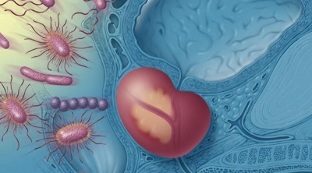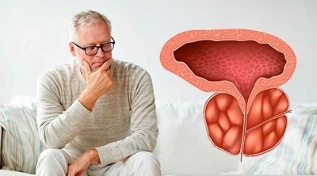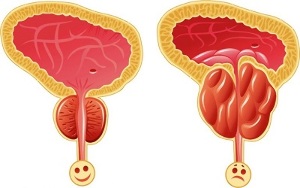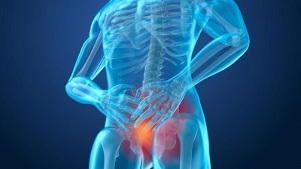
Describe the causes, symptoms, diagnosis and treatment characteristics of acute or chronic bacterial prostatitis. The urologist’s advice will help you quickly identify the disease and contact the clinic in time for diagnosis and prescription of complex treatment.
Prostatitis is one of the most common urological diseases in men. Prostate inflammation can bring discomfort to life and may cause sexual weakness.
According to various estimates, after the age of 40, one-quarter to one-third of the male population suffers from prostate disease. The statistics among young people are better, but they are still not satisfied.
Today, we will discuss bacterial prostatitis (BP), considering its causes, symptoms, and characteristics of diagnosis and treatment.
Cause of occurrence
The complexity of PD is that it is usually performed in a subtle form and has not been detected for a long time, which delays the start of treatment.
The main cause of bacterial inflammation of the prostate is gland infection, but it not only causes disease.
Among the causes of bacterial prostatitis, we noticed:
- Sedentary lifestyle.
- Violates the rhythm of sexual life.
- Overweight.
- Chronic constipation.
- Alcoholism.
To understand how these causes affect the occurrence and development of pathology, let us consider their specific circumstances.
Microbes and infections enter the prostate regularly, but this does not always cause bacterial infections because the immune system is working.
In addition, good blood flow will quickly take away the infection and stimulate local immunity in the glandular area, thereby preventing infection.
Interesting!The sedentary lifestyle and irregular sex have formed congestion in the prostate, which is another factor in the onset of the disease.
If you are sedentary, it is a good idea to go to the gym or exercise your buttocks at home after the age of 40 or even earlier.
Obesity and chronic constipation can also affect blood flow in the gland area. Track your weight and add high-fiber foods to your diet to prevent constipation.
As for alcohol, it weakens the immune system (often abused), thereby eliminating the body's protective barrier, and it is easier for microorganisms to "establish a foothold" in the prostate.
Please remember that bacterial prostatitis does not start from scratch. In most cases, the disease appears in people who do not pay attention to their health.
The symptoms of this disease
Like any other disease, PD has its own symptoms, the severity of which varies with the stage of the disease and the characteristics of the patient's body.
In most cases, people with prostatitis will worry:
- Urinating frequently.
- Feeling pain when going to the toilet.
- The weight of the groin area.
- Decreased libido until erection problems.
The most obvious symptom is that when acute PD occurs, if treatment is not started, the disease will become chronic and the severity of symptoms will be relieved.
There is no need to rejoice here, because chronic inflammation is more difficult to treat and treatment takes more time.
Important!If you have the first symptoms of prostatitis, then this is the reason to go to a urologist and get a diagnosis, because starting treatment quickly increases your chances of success.
Acute prostatitis
In the acute form, the patient may even experience a rise in body temperature of up to 40 degrees and fever. The pain in the groin can be severe, and there will be purulent discharge in the urethra, so the urge to go to the toilet is very frequent.
 Acute bacterial prostatitis in men cannot be ignored. This is its advantage, because the patient immediately goes to the urology department.
Acute bacterial prostatitis in men cannot be ignored. This is its advantage, because the patient immediately goes to the urology department.
In an acute state, there is a strong burning sensation when going to the toilet, and can cause irritability and fatigue throughout the body.
If treatment is not started in time, PD may cause complications:
- An abscess in the prostate.
- Vasculitis.
- Colitis.
- Scar changes in the prostate.
Colitis is also dangerous. Severe pain syndrome can occur during sex, which may lead to psychological trauma and impotence.
Scarring changes can cause infertility because it reduces sperm motility and sperm quality. In addition, the narrowing of the scarred urethra makes it difficult to urinate and causes bladder obstruction, which may be the reason for the intervention of the surgeon.
Chronic form
Chronic bacterial prostatitis is primary or secondary. In the first case, it develops immediately without an acute phase, and in the second case, it appears as an advanced form of acute inflammation of the prostate.
The symptoms of the chronic phase are more vague, but they also make the patient feel uncomfortable:
- Difficulty urinating.
- The desire to use the toilet is increasing.
- Impaired erectile function.
These are the main signs of chronic PD. If treatment (complex therapy) is not started on time, the following forms of complications may occur:
- Cystitis.
- Sepsis.
- Pyelonephritis.
- Decreased immunity.
The danger of this disease lies in the less obvious symptoms. Sometimes men don't pay attention to these symptoms at all.
If it is impossible not to pay attention to the acute phase, then the chronic inflammatory process is usually ignored, so the treatment time is long and not always effective.
Inflammation diagnosis

When the first symptoms of prostatitis appear, you need to see a doctor, who will prescribe a set of diagnostic measures. They will make it possible to determine the presence and type of inflammation, which will help to effectively treat the disease.
The complete diagnosis includes:
- Digital examination of the prostate.
- Prostate secretion analysis.
- is a venereal smear.
- Ultrasound examination.
The doctor may also need semen analysis and biopsy to rule out or confirm the presence of prostate cancer.
The digital examination of glands is unpleasant, but it is an important stage of diagnosis because the patient is simple, the density is uneven and the volume increases.
The analysis of secretions will determine the infectious or non-infectious form of the disease, and ultrasound will help doctors see the outline of the gland-if the outline is blurred, prostatitis can be clearly confirmed.
After diagnosis, the urologist decides the patient's treatment based on the following factors:
- Types of prostatitis.
- The form of the disease.
- The age of the patient.
- Individual characteristics of the patient.
- The presence of accompanying diseases.
Accurate diagnosis allows you to choose the best treatment plan and the best treatment effect. The more stages required for a diagnosis, the more accurate the diagnosis will be and the easier it will be to prescribe complex treatments.
Treatment of prostatitis
The treatment of acute and chronic bacterial prostatitis is different because it requires different doses of drugs and the treatment time is also different.
Interesting!After the doctor’s task is to completely get rid of the effects of the disease, in the initial stage, eliminating the patient’s symptoms is very important to improve the quality of life.
Acute prostatitis treatment

In the treatment of acute prostatitis, an upright treatment must be prescribed; in the case of bacterial diseases, antibiotics and antibacterial agents cannot be used.
In addition, the following is assigned:
- Analgesics.
- Immunostimulant.
- Vitamins containing trace elements.
- Massage.
Important!Antibiotics and antibacterial agents can fight bacteria, while vitamins and immune stimulants help strengthen immunity.
In the acute course of the disease, massage cannot be prescribed, and physical therapy such as laser and electrophoresis is not recommended at this stage.
They are required for treatment, but they are not recommended in the acute phase of PD.
Treatment of chronic prostatitis
The treatment of chronic bacterial prostatitis requires longer treatment time and more procedures. Usually need to increase the drug dose.
Add to the above treatment stage:
- Receive phytoremediation.
- The complete range of physical therapy.
- Do special exercises.
- Consult a psychologist.
As the potential for treatment decreases, it may be necessary to increase the dose of vitamins and stimulants, as this treatment requires regular sexual activity.
As for the exercises, choose according to age, disease progression and individual characteristics of the organism. In addition, the doctor also considered the existence of side effects.
From this article, you learned how to determine bacterial prostatitis, and then you only need to carefully monitor your health and consult your doctor when the first symptoms of the disease appear.
The sooner treatment starts, the shorter the course of treatment and the faster the person will return to a full life.

























